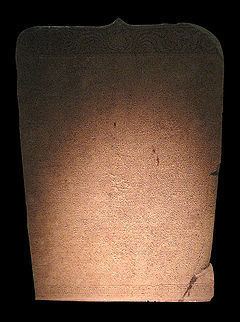Material Andesite stone | Created 732 CE | |
 | ||
Discovered Present locations | ||
The Canggal inscription is a Javanese inscription dated to 732, discovered in the Gunung Wukir temple complex in Kadiluwih village, Salam, Magelang Regency, Central Java. The inscription is written in the Pallawa script in the Sanskrit language. The inscription documents an edict of Sanjaya, in which he declared himself the universal ruler of Medang.
Content
The inscription describes the erection of a lingam (the symbol of Shiva) on the country of Kunjarakunja, by Sanjaya's order. The lingam is sited on the noble island of Yava (Java), which the inscription describes as "rich in grain and gold mines". Yawadwipa, the inscription says, had long been under the rule of the wise and virtuous king Sanna, but fell after his death into disunity. Amid a period of confusion Sanjaya, son of Sannaha (the sister of Sanna) ascended to the throne. Sanjaya mastered holy scriptures, martial arts, and displayed military prowess. After the conquest of neighboring areas his reign was peaceful and prosperous.
The inscription makes reference to Kunjarakunja-desa, perhaps meaning "the hermitage land of Kunjara", which has been identified as the hermitage of Rishi Agastya, a Hindu Maharishi revered in Southern India. The Ramayana contains a reference to a visit to Agastya hermitage on Kunjara by Rama, Sita, and Lakshmana.
The name Sanjaya, Sanna and Sannaha curiously was also mentioned in Carita Parahyangan, a book from later period composed around 16th century which suggested refer to same historical person.
